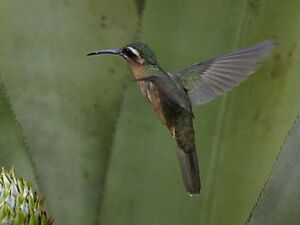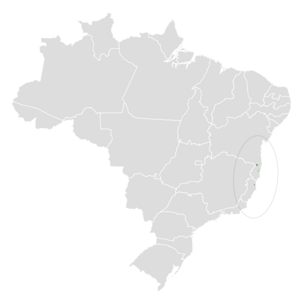Hook-billed hermit facts for kids
Quick facts for kids Hook-billed hermit |
|
|---|---|
 |
|
| Conservation status | |
| Scientific classification | |
| Genus: |
Glaucis
|
| Species: |
dohrnii
|
 |
|
| Synonyms | |
|
Ramphodon dohrnii (Bourcier & Mulsant, 1852) |
|
The hook-billed hermit (Glaucis dohrnii) is a special type of hummingbird that is facing a risk of disappearing. It belongs to the Trochilidae family. This tiny bird lives only in a small part of Brazil, which means it's endemic to that area.
Contents
Meet the Hook-Billed Hermit
What Does It Look Like?
The hook-billed hermit is a small bird, about 12 to 13 centimeters (around 5 inches) long. That's about the length of a pen!
Male birds usually weigh between 6 to 9 grams, and females are a bit lighter, weighing 5.5 to 7 grams. Their upper parts are a shiny greenish-bronze color. Their bellies are a warm cinnamon color.
Their face has a white stripe above the eye, like an eyebrow, and a white "moustache." The rest of their face is dark. Their tail feathers are a metallic bronze with white tips on the outer feathers. They have a bill that is almost straight. Both male and female hook-billed hermits look very similar, but the female's belly might be a little lighter in color.
Where Do They Live?
The hook-billed hermit is found in only a few places in southeastern Brazil. You can find them in the states of Bahia and Espírito Santo. They live in tropical forests, especially near the coast or further inland.
These hummingbirds prefer to live in the lower parts of old, untouched forests, often close to streams. They really like areas where there are many Heliconia plants, which are a type of flowering plant. They can be found from sea level up to about 500 meters (around 1,640 feet) high.
How Hook-Billed Hermits Live
Daily Movements
Scientists believe that hook-billed hermits usually stay in one place and do not travel far. They are thought to be sedentary, meaning they don't migrate like some other birds. However, because they are so rare and hard to find, it's difficult to be completely sure about their movements.
What Do They Eat?
Like many other hermit hummingbirds, the hook-billed hermit is a "trap-line" feeder. This means it visits a regular path of flowering plants to find food. They mostly drink nectar from flowers, especially from Heliconia plants. They also eat small arthropods, which are tiny insects and spiders.
Reproduction and Life Cycle
The breeding season for the hook-billed hermit is thought to be from September to February. They build their nests using plant materials and spiderwebs. These nests are often found hanging under the tip of a long, drooping leaf. A female hook-billed hermit usually lays two eggs at a time.
Their Song
The song of the hook-billed hermit sounds similar to other hermit hummingbirds. It's described as a fast "seep-seep-seep." It can also sound like a series of "seee" notes that go down in pitch.
Protecting the Hook-Billed Hermit
The hook-billed hermit is a threatened bird. Its population is decreasing, and it's very important to protect them.
The IUCN (International Union for Conservation of Nature) has changed its status over the years. In 1988, it was listed as Threatened. Then, in 1994, it was listed as Critically Endangered, meaning it was very close to disappearing. In 2000, it was listed as Endangered, and in 2021, it was listed as Vulnerable.
The main reason for their decline is that their forest homes are being cut down. What's left of their habitat is broken into small pieces. Experts believe there are fewer than 10,000 adult hook-billed hermits left in the wild. Their numbers are still going down. They might now only live in a few special nature reserves and national parks in Bahia and one in Espírito Santo. Protecting these areas is key to helping this unique hummingbird survive.


